#Isometric Game Tutorials
Explore tagged Tumblr posts
Text
I think there's always fun discourse to be had whenever it comes to the definition of a genre. And by that I mean I have to fight anyone who disagrees with me
#but not as much as the guy out there who said crpgs didn't have to have rp and shouldn't have quests#but needed to be isometric and should be turn based and 2D or you were on thin ice and seemed willing to kill over it#thinking about that guy#definition also included that it should be so hard that most people who played it died in tutorial and quit#as much as that guy is a bit out there I don't consider any very action focused 3D game without RP even potentially a CRPG#so really who am I to judge. skyrim isn't a CRPG or any kind of RPG even. and yet some people hold... a mysterious other belief.#rambling
14 notes
·
View notes
Text
Mastering Isometric & Isomorphic Game Design: A Quickstart Guide to Unlocking 3D Potential in 2D Worlds
We say that: “oh I love that Baldur Gate, let’s crack out an isometric.” Or, “oh, digging this Final Fantasy Tactics stuff, let’s do that sideways angle thing.” But what does that mean? Let’s break it down mathematical. T:(X,∥⋅∥X)→(Y,∥⋅∥Y) is a isometric isomorphism if it is a linear isomorphism, and it is an isometry, that is ∥T(x)∥Y=∥x∥X∀x∈X; T:(X,∥⋅∥X)→(Y,∥⋅∥Y) is a topological…
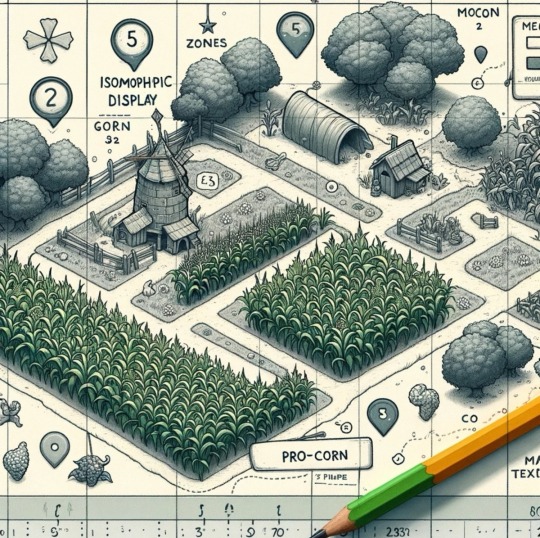
View On WordPress
#2D Game Development#3D Game Aesthetics#Bijective Transformations#Game Design Innovation#game design lessons#Game Design Principles#Game Design Strategies#Game Design Tutorials#game designer#Game Development Blog#Game Development Techniques#Game Environment Design#Game Graphics Design#Game Mechanics#game studies#Game World Consistency#game writer#game writing#indie game dev#Isometric Art Style#Isometric Game Community#Isometric Game Design#Isometric Game Engines#Isometric Game Tutorials#Isometric Graphics#Isometric Indie Games#Isometric View#Isometric vs. Isomorphic#Isometry in Games#Isomorphic Maps
12 notes
·
View notes
Text

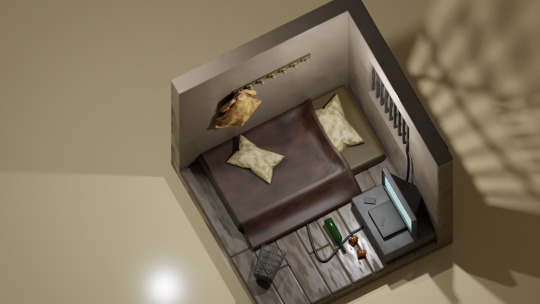

Homeless isometric room in blender 3.6
#art#artists on tumblr#youtube#3d artwork#blender#3drender#design#3d model#gaming#tutorial#isometric#isometric room#room design#3d modling#3dart#3d#3dartist
2 notes
·
View notes
Text

Hello! In this post I will share some tips I have to help you on your custom content making journey. These are more general rather than creating a specific item, but I may make another part in the future!
Things covered: learning curve of blender, free resources, learning your computer, using references

1️⃣ There’s no need to pay for anything
The only money I have spent on anything related to TS4/custom content is for some of the expansion packs. Every resource I have used I have only had to pay with time. Blender, Sims 4 Studio, and Sims 4 Tray Importer are all free! And for Photoshop, a good free alternative I use is Photopea, which is just a web version. Another good alternative is GIMP, which is an application.
There are applications like Substance Painter and Marvelous Designer, but I would only recommend those if you have a genuine interest in 3D modeling outside of TS4.
And in terms of finding tutorials, scouring the internet will always lead to some result. A good tumblr page is @thefoxburyinstitute, which has many sections based on your level of experience. Adding “reddit” to the end of a search helps too!

2️⃣ You can export anything from Sims 4 Studio as a reference (mod or EA object)
For an EA item, In S4S, go to Tools -> Browse Game Content -> then select the category you need a ref. If it’s a mod, click on My Projects and find the package you want.

From here, you can export the mesh, images, or any textures you need without having to create a new package for it! Best used when you have already created your own package and just need one aspect of the object.
If you want to append in Blender, go to File -> Append (works with any .blend file exported from S4S), then find the location of whatever you exported. Go to the Object folder, find anything labeled s4studio_mesh_number, then append. I just append all of them, then delete ones I don’t need.

Also, in the Scene tab, make sure the cut box is blank for the reference you imported! S4S will confuse this with your mesh if not, as the cut number determines which mesh will replace the EA one.

3️⃣ File management is important!
The more you create, the more random things you’ll download on your computer. You need to be aware of where you’re downloading things from, duplicate files, how much storage it’s taking up, etc. I recommend the Sims 4 Mod Manager by GameTime. Back up your files often and learn how your computer works because every device is different! Below is how I organize my CC (could use some improvement), but use whatever keeps you organized.


4️⃣ Learn Blender outside of Sims 4 CC
There have been so many times when I’m so frustrated about Blender that I have to take a step back and focus on a different hobby. The first time that happened years ago, I decided to learn how to make simple models in Blender, and not only did I enjoy it, but I also learned so much that can be applied to CC! Below are some tutorials that I watched.
Blender 3D Beginner Tutorial by 3DGreenhorn
A simple room tutorial.
3D Isometric Bedroom by artbytran
Another simple room tutorial, but with more cute details.
Creating Stylized Low Poly Characters by lacruzo
How to make a low-poly character and texture paint on it (I used this tutorial to texture paint on a hair clip!)
Intro to Creative Web Development by Andrew Woan
Okay I know the 5 hours is daunting, but only (lol) the first 2 hours are Blender. This video goes more into the technological aspect and making models optimized for video games/web (ahem TS4). After the 2-hour mark, it's all coding, which is not needed for CC making.

5️⃣ It takes time/consistency
As a person who only makes CC once every other month or so, it’s mostly muscle memory and consistent practice that makes someone feel confident in their CC making abilities. Remember how as a kid typing was the slowest thing ever, and today you’re (hopefully) better? It’s cause you kept practicing over a long period of time.
The first time I opened Blender to make poses was in 2021, and 4 years later, there’s so much that I have learned from others, and 10x more that I don’t know due to the endless possibilities of what can be created. But hey, I’m confident enough that I made this post of tips, right? Take small steps, the end goal is to make something you or others enjoy.

Thanks for reading this if you’ve come this far, and here are two pages I recommend reading to help you on your CC journey! :D
Internet safety regarding TS4 by crazy-hazy-sims (pls read this) Custom Content Creation by simlaughlove
9 notes
·
View notes
Note
what program do you use and/or which brushes for Alternia Beta Clones? /genq
Thanks for asking, I really wanted to talk about it! :D
(It's going to be a bit long so I'll put it in 'Keep Reading' xD)
To draw my panels, I use Clip Studio Paint. And for the brush, I use the basic nib (Plume G) with no anti-aliasing effect!
I also use 714 x 441 px format so that you can see the pixel effect better.
Why 714 x 441 px precisely? Er… actually, it's mostly due to a mistake when I made my first panels. Basically, I wanted to use a 600 x 400px format, and I must have made a mistake when creating the file! But I like the way it looks in the end.
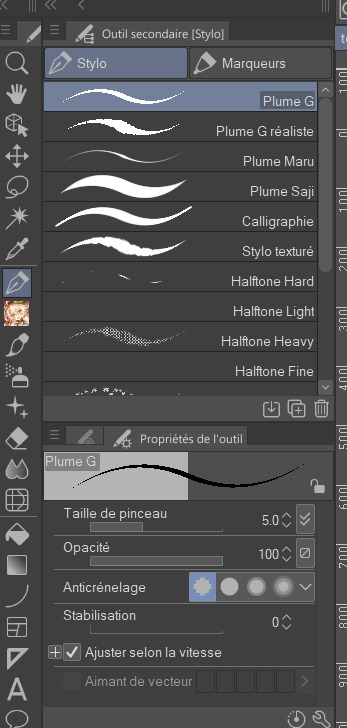
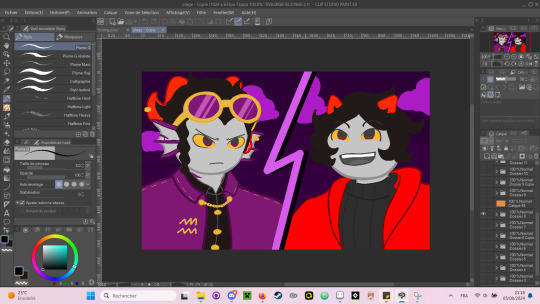
Otherwise, I originally made the character sprites on Clip Studio Paint, using the same brush as before. But I quickly realized that it wasn't the most adaptable, and now I'm reworking all my sprites on Aseprite! It's a software specialized in pixels. I've also started doing some backgrounds there! (Like Eclass hive)
CSP :
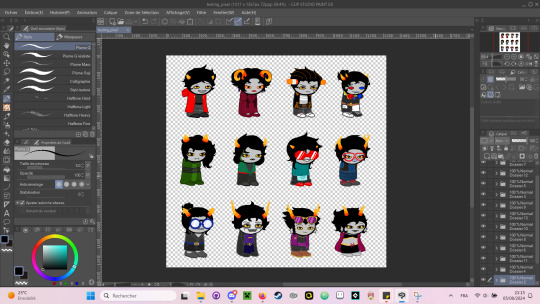
Aseprite:
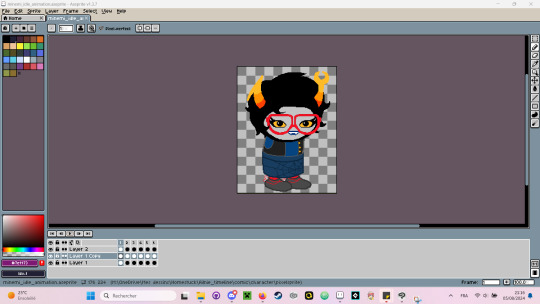

By the way, for the environments, I'm using a script I found on itch.io to make isometric boxes. (HERE)
For the video part, I edit on Movavi! And by the way, I don't compose my own music, I go through OpengameArt ( I update my credits document if you'd like to see the music I use).
And finally the video game part! For the moment I've only used renpy, mainly because I'm familiar with coding with it. It's not necessarily the most optimized if you ask me! I did the clicker on it, but renpy is better suited to visual novels! (maybe I'll put some visual novels in Alternate Beta Clone too?)
Otherwise, I'm learning how to use GameMaker and I'd love to make games on it, so let's see in the future! :D
(Note that Renpy and Game Maker are free, and there are lots of tutorials on the net! You can also find resources on itch.io)
#ask#ask me anything#homestuck#fantroll#alternate beta clones#aseprite#movavi#clip studio paint#game maker#itch.io#game development#mspfa#mspfanventures#hom3stuck
7 notes
·
View notes
Text
Sea of Stars Initial Thoughts
I started on Sea of Stars last night. Quick assorted thoughts (bulleted with asterisks because tumblr autoformats my preferred > bullets):
*I was actually really bored for the first hour or so. I don't like extended childhood flashbacks all that much, and they teased us with the adult protagonists before sending us through the flashback/montage of all time. I got why we needed to see Valere and Zale and Garl enter into the forbidden cave and have Garl get hurt. But afterwards, I feel like a good film editor could've cut the sequence where Valere and Zale start training, start sewing, continue sewing, continue training, train some more, say their solstice warrior vows, complete their final training test, and walk through the first dungeon before flashing 5 minutes forward to the tutorial at the start of the game. My beef is not with the extended academy sequence, but with having the game start with them as adults if it's gonna flash back that quickly for that long. **BUT I can at least see what they were going for because Garl seems to be the emotional center of the game thus far, and that has real narrative potential. It frames the story so that we're introduced to Valere+Zale, they're very open about the guilt and regrets of the incident that led to Garl losing his eye, and then we see how it happened and how they never saw him for ten years since. But then the cookie jar+note shows up midway through the montage, and it's pretty clear he doesn't hold a grudge and still cares for them, and they still care for him. **Then he shows up in modern times as a jolly giant with cooking skills and a sincere desire to come along and help. Valere and Zale are actually hesitant to let him come, without any adults present to tell them no, because they know how dangerous it will be. But he sticks it out and makes his point that the cooking and beefy physique make him an asset, and the three friends are reunited with another huge hug. It's very sweet, but it also highlights that Garl, despite not being "chosen", has something that makes him an indispensable part of the group. Dude's got a great attitude and is keeping himself in the battle party through years of hard work not unlike what Valere and Zale experienced in the opening hour. **Like, between the Archivist and Elder Mist's vague statements about slight diversions from the initial timeline/Garl's unique potential of bringing "it" back, I wouldn't be surprised if he was the secret sauce that saves the world when all is said and done. And if that happens, 11/10 writing.
*Combat is so-so so far. The combined mechanics of timed hits/breaks are hit or miss in my book. I always feel like I'm leaving stuff on the table, and it feels like a more button-mash heavy version of Octopath Traveler's break/boost system without the corresponding ability to autopilot vs mobs because attention is always needed to block enemy attacks. It feels mechanically like a game that considered various criticisms of turn-based RPGs and ended up with mechanics that might attempt to appeal to people who didn't like the genre to begin with. That said, only 90 minutes in and ready to reconsider my opinion as new info comes to light.
*I wanted to hold off on Crosscode comparisons, despite the fact that both are heavy on isometric platforming elements and hidden object-heavy environments. But then the Forbidden Cave literally had a Laser Bridge!
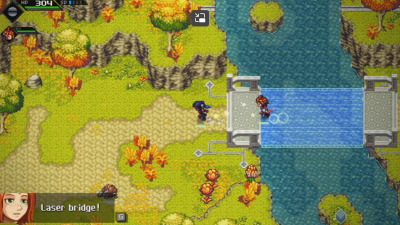
Emilie-Sophie de Belmond would be proud.
10 notes
·
View notes
Text
Wasteland 3: First Attempt, First Opinions
So far, I've played through the first mission up to the point of meeting the Patriarch, so I'm not very far in at all. Also worth mentioning that I'm coming at this from a Fallout background and currently have zero familiarity with Wasteland specifically.
My squad so far is these two!
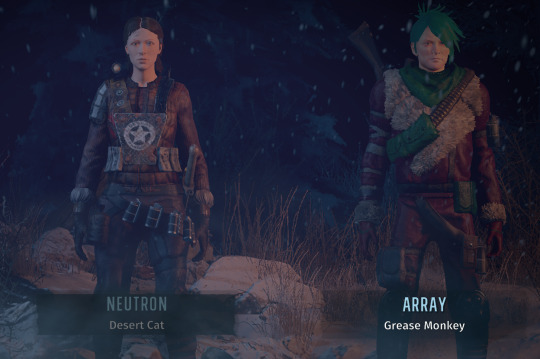
I'll introduce them properly as characters further down the line once they have a bit more actual lore, but suffice to say that they're iterations of half-baked Fallout characters and will inevitably develop Wasteland AU versions over time.
First impressions:
Regarding the gameplay, turn-based combat isn't something I'm used to, but I definitely prefer it over live combat in this isometric game style
I have tried and failed to play the classic Fallouts in the past, with that mostly failing because I struggled with the overall clunkiness of the game and combat system. If anyone else in the same boat is considering trying Wasteland, it's way easier to control!
So far, things have been heavy on gore in both actual imagery and verbal descriptions. Whether this is a positive or negative to you, I think it's at a level that warrants being aware of
I haven't encountered any confusion due to not being familiar with the previous Wasteland games yet. Feels like the game expects that from the audience and gives you a blank-ish slate to start from
Mini screenshot dump:
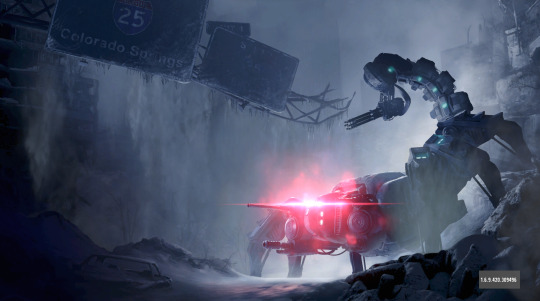
The initial menu screen is epic.
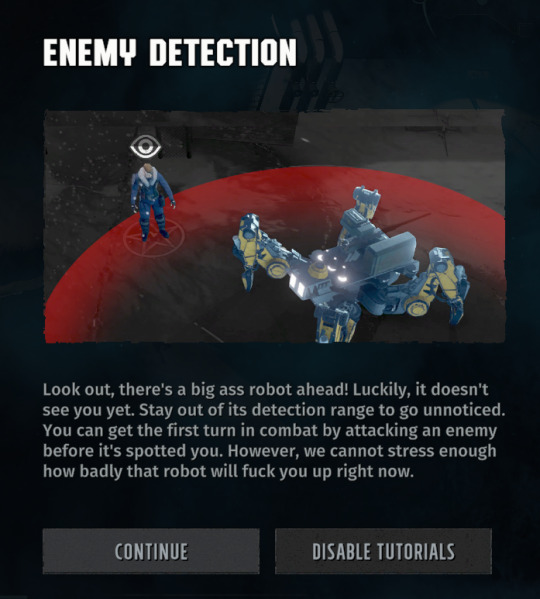
The tutorial really takes itself seriously.
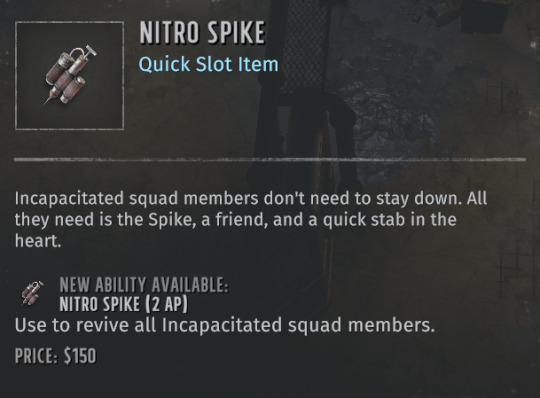
Purely took this screenshot for my own reference because the item looks incredibly similar to some Fallout chems.
#wasteland 3#also a note:#as I get further in the game I may end up posting spoilers#if anyone is planning to play it and wants to avoid that then the tag to block will be#chaos plays wasteland 3
5 notes
·
View notes
Note
hi i recently started learning pixel art :) do you have any tips/techniques that you've learned that you'd like to share with others?
Hello hello! Although I've been drawing for around a year now, I can't really say I have any specific tips or tricks referring to pixel art... Reason for this is because I'm extremely eccentric when it comes to pixel art despite it being all I do. I'm not good with low resolutions or colours or any of that, it just doesn't stick in my head, which is why if you look at my art you will notice all my pieces are decently sized and very monochromatic. I could say basic things like "avoid unintentional jaggies [when you are making a curved line and it goes from 1px in a direction to 2px just to go back to 1px (makes it looks rough and awkward unless done intentionally)]" and stuff but that's stuff you could get from anybody else. All I've done was really just look at other people's art (doesn't even need to be pixel!) and learn concepts and stuff from normal art to apply to pixel. Lack depth? Study shapes and volumes. Proportions are off? Learn basic anatomy and so forth. But honestly the only real advice I truly feel I can give out, is to just connect with others. Talk about your art, share it, ask for pointers if something feels off to you, notice mistakes in your old art you could only see after growing so much. Look at how other people draw and gain inspiration. Pixel art isn't really different from any other art, we're just deciding to go with palette or size limitations because we want to, what you can learn from any art tutorial you could apply to pixel too. Find out what kind of pixel art you want to make, game sprites? Isometric? Illustrations? Once you find the form you enjoy the most focus your lens on tips more geared towards that. I'm sorry I couldn't really give an answer to your question.. I've been sitting on it for a few hours now wondering what to say because I couldn't think of anything. My message box and stuff is always open if you want to reach out and connect or ask anything else in specific in response to this because idk how helpful any of this was.
2 notes
·
View notes
Note
I love your OCs and I especially appreciate the time you put in creating gif sets with your dialogue in the color of your particular OC. Sorry in advance, I have lots of questions ahead!
Do you have any tips for someone who’s just starting out with Baldur’s Gate 3 and playing around with character creation? Do you spend a lot of time with resources that are already available or is there a particular mod or two you use to get details just right?
Do you usually have an idea of what you want/a character backstory in mind and just breathe it to life?
I’m glad I stumbled upon your blog!
hiii! thank you so much for the kind words. ♡ happy to have you here! no need to apologize! i don't mind questions at all. i don't have many tips gameplay wise, so if you don't have an experience with isometric RPGs, i would advise you to keep the tutorials on. it's a bit of a learning curve if you're not used to it, but it's not super hard to get into. the game is really fun once you get the hang of it.
as for character creation, i am a bit of a mod whore and use several mods in almost any game i play. that being said, the vanilla game still has tons of options to choose from to customize your character. i would def boot it up w/o mods first to play around with all the options and see what you can come up with. i usually have an idea in mind before i create a character, whether it be a color palette i want to experiment with or just a random idea that popped into my mind from a quote or song i'm listening to. however, there have been times where my characters were purely born from seeing a certain mod and wanting to create a character with that asset. (like horns, hair, tattoos, a modded head, etc.) i tend to lean more towards elves or horned characters, which is the whole reason i have so many tieflings lol. horns, fangs, and pointy ears? sign me up! as for their backstories/personalities, it all depends. there have been times where my characters backstory was already forming before i made them, like my werewolf Ylva, and there are other times where their story came much later after their creation, like Khione. i will say the majority of their backstories come after i've made them, and i play around with dialogue options in game to kind of flesh out what feels right for them. i also keep a personal Discord where i ramble when the ideas hit me and individual Pinterest boards for inspiration on their personalities. i hope this helps! just know there is no right or wrong way to breathe your characters to life. sometimes their stories or looks might change drastically after you've started playing them and you switch it up, but it's so fun once that creative wave hits you. i also have a page where i list all the mods i use here, but please be wary that some contain spoilers for the main game, so i would def run a vanilla playthrough first before playing with mods. i also have some that are personal mods that aren't released, so always feel free to ask what outfits, accessories, horns, faces, etc i'm using on a certain gifset and i'll do my best to link them for you!
2 notes
·
View notes
Note
so i'm interested in Kingmaker, but also the reviews are... scary. like, is it a really difficult game? everyone seems to be saying it's extremely unfair, and as a crpg newbie, i am. not very good at these types of games
I think it depends on how new you are to these kind of games! I think the game itself was not particularly hard (I used easy mode!), and the mechanics are similar to other D&D games. It also depends on how much you would like to learn playing/fighting vs how much you want to enjoy the story.
I am not a fan of fighting in Pathfinder Kingmaker so I usually stay in easy mode and I never had any difficulty (there is a turn based combat mod available too). The game is basically divided in:
Combat encounters: the tutorial explains very well, and in easy mode it is quite doable!
Kingdom management: you will have a kingdom to check on regularly at your base, to decide what happens to it (investments, make new settlements etc.). There is an easy mode for this too! I remember I did not have particular difficulties and even failing at something will end up with interesting choices consequences (but it you want there is this great mod that allows you to change stuff)
Dialogue! choices! So so many choices. This game really allows you to choose so many different things and find different routes based on your alignment, previous choices, persuasion etc.
In general, the plot is okay, the companions are amazing, in my opinion.
Still, it is up to you! Did you play Dragon Age Origins before? I think that is usually the easiest most welcoming crpg because of the mix of isometric combat with pause (like in Pathfinder Kingmaker) and story and companions!
4 notes
·
View notes
Text
Have you tried Cozy Room Decorator?
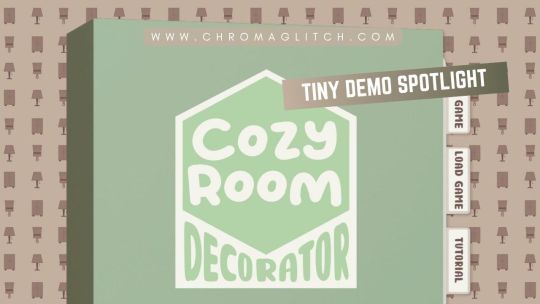
Developer: Lucky Roll Studio
Release Date: March 22nd, 2024
Price: $14.99
Platforms: Steam
Cozy Room Decorator is a simple isometric interior decorator game where players will turn thousands of items into unique creations. Players can customize the walls using patterns and a Hue Saturation and Lightness color slider. They also have options to freely rotate, scale, and elevate each item in the game.
In addition to the interior of the room, players can also decorate and furnish the exterior and adjust the time of day and weather to set a mood for their room. Players can also merge items to create even more unique visual designs. In the Cozy Room Decorator demo, players will test out the tutorial section of the game. This will give them access to a limited selection of items to decorate a single room with. Since the Cozy Room Decorator demo only accesses the tutorial of the game, the demo can be completed in ten minutes or less. Cozy Room Decorator is currently available on Steam for $14.99.
1 note
·
View note
Text
Video Games I Played in June 2025

Near the start of June I got a check from the state saying that they’d found an account in escrow that was rightfully mine. Likely it was a last paycheck that was never sent or something similar, but it ended up being $180 of fun money that I went out of my way to blow on games. The result was me blitzing through 22 different games, and while I dropped several of them and/or still need to finish them in the coming month that’s a huge number compared to my already aggressive baseline of consumption. Turns out when I don’t have a game eating 30+ hours of my month I have time for a half-dozen 5 hour games.
Doom: The Dark Ages – I am resolutely immune to the siren song of “schmoovement”. 2D, 3D, first-person, third-person, it does not matter. The joy of momentum and graceful flow does not sing to me. I’m not sure that’s the reason I bounced off the newest Doom before even finishing the tutorial, but the increasingly earnest embrace of Quake-style movement (to say nothing of Quake-style overwrought bombast) certainly drives a wedge in. I won’t say this didn’t learn any lessons from Eternal, but I feel like it made some of the right moves for the wrong reasons. I’m all for a series being willing to introspect and abandon sacred cows in pursuit of what the true core actually is and how it can be recontextualized; but rather than transformative this feels aimlessly reductive. Movement absolves the need for positioning, resource loops remove any tension of attrition, color and light and spectacle replace structured level design. The result isn’t “bad” by any reasonable metric, but it’s resoundingly not for me.
Tomb of the Treacherous Toad – From the lauded creator of indie darlings Port Madrone and PewPew comes the latest certified hood classic. Its epic labyrinths and devious puzzles are matched in scope only by the depth and passion of the narrative woven through them. We live in inspired times, and even someone such as myself that shies away from VNs was smitten. (My partner made a cute 15-minute VN in Ren’Py, check it out - https://haleybellart.itch.io/tomb-of-the-treacherous-toad )
Plague of Yamorn – I first tried this last year but got my save corrupted by a glitch stemming from a death in the tutorial. I came back after the dev made a few patches, and I’d only lost 15 minutes or so of progress on a restart. My record for biting my tongue and replaying a game is ~2 hours for Tales of Kenzera: ZAU after I locked myself in gay baby jail by walljumping out of a level and getting autosaved in an area where the collision was loaded but the path out wasn’t. Rough start aside, despite being transparently inspired by Bloodborne (though it took me longer than I’d like to admit to notice the Yamorn/Yarnom connection) it’s doing its own thing with the setting and lore. Like a lot of metroidvanias from small teams or solo devs there’s some odd one-offs to the design where things that could’ve been major mechanics are only used once, and the entire crafting system was a bit tacked-on. I still found it well above average, though I didn’t have the patience to pixelhunt through every room looking for the true ending. The writing was a particular high point with several jokes being worth the price of admission on their own.
Trinity Fusion – It took me a while to realize I don’t actually like roguelikes, and I’m not sure if that’s genre fatigue or the fact I’m good enough at the triad of mystery dungeon, isometric action, and metroidvanias that I can typically get far enough on raw skill to be stat-checked by deliberately lopsided balance and forced into the metaprogression meat grinder. Trinity Fusion was definitely one where I would’ve been interested in its setting and gameplay loop if it was just a normal metroidvania, but I wasn’t going to slog through the early game dozens of times just to explore the systems at their apex. Giving the three versions of the protag their own drop pool that you could spend currency in the run to merge together was novel at least, though I don’t think it did much more than emphasize how shallow that pool was even in aggregate.
Cauldron – I wanted to make number go up and Cauldron certainly promised that. It’s a collection of minigame modes spread across an overworld you clear through turn-based combat against set enemy arrangements. The main perk is that you can upgrade each minigame and each party member through several layers of overlapping systems. Some of these were genuinely inspired like the apple-catching minigame growing and evolving with larger baskets and 2D flight until you were playing a bullet hell shmup, or the mining minigame getting increasingly elaborate tools and powerups so the focus became chaining multipliers through the whole level rather than focusing on counting steps. The issue is that most of the game just became shallow and frustrating, and when all the systems are interlaced any one failure bricks the entire mechanism. Similar to Swords & Souls I had a good time fucking about in some flash-tier games and stopped when I got bored. That’s not a fail state for a game.
BURGGEIST – What if Team ICO made a tower defense game about a mage with a borrowed arm throwing fireballs from the back of a cannon-laden homunculus? If that question at all piques your interest, nothing else I say could change your opinion. If that question doesn’t pique your interest, there’s nothing else TO be said. I don’t even know if I like this game, because for the third time I have fallen for the Brutal Legend gambit, but I love this game.
Pipistrello and the Cursed Yoyo – This game is a lock for my top 10 of the year. It’s the best 2D Zelda since Oracle of Seasons with endlessly clever puzzle design, incredibly unique combat, and a top-notch aesthetic. I could take or leave the Saturday-morning-cartoon tone but the rest of what’s on offer more than makes up for it. I have no idea how this didn’t explode in popularity because it’s absolutely top-notch.
Clay Beats – I’m at a loss as to how this got into my library but I sincerely hope it wasn’t by paying money. Co-op meandering on an animal crossing island and making pottery by playing DDR rhythm games sounded like a good time but this game was just straight up unfinished. Terrible sound mixing, dodgy detection for the DDR, and glitchy NPCs galore, though the masterstroke was a raccoon whose black face marking had its height tied to the player’s location so it gracefully fell onto his eyes from heaven like a 2010s Deal With It meme.
Laika: Aged Through Blood – This sat on my wishlist for over a year with me always assuming I wouldn’t quite like it. Eventually gave it a go. Didn’t like it. You die in one hit, whether that’s from bullets or eating shit on concrete. You have to manage motorcycle flips to reload and refresh your parry ability. The twinstick aiming isn’t bad but for someone already not keen on it doing so while riding a bike was unpleasant. The fact the tone was needlessly brutal and sadistic didn’t help; opening on a character being vivisected and crucified with their own intestines isn’t really my speed.
After Death – Fuck this game rules. You are a skeleton who punches other skeletons, and every boss is more covered with bones and spikes than the last. The fire/ice powers being used for a variety of water melting puzzles didn’t exactly gel with the vibe but they were certainly inventive and used cleverly. Similar to Plague of Yamorn I didn’t have the patience to put up with the room-by-room scouring required for the secret ending, but I enjoyed my time overall. The music was pretty solid too.
The Auto Sort Is Broken – I’m one of the freaks that thought the inventory management in Kingdom Hearts: 358 Days/2 was fun, so I’m always curious about these sorts of games. Save Room was short but cute, Backpack Hero was amazing but got overcooked in early access, and while there’s slivers of what I’m after in games like Dredge nothing has scratched the itch. This definitely isn’t it though, the puzzles repeat often and the drag-and-drop inventory UI is godawful, particularly for a game where that is the entire game.
Lost in Random: The Eternal Die – Lost in Random was a game I liked more than I expected and think back on with quite a bit of fondness. I was hoping this action roguelike would have elements of the unique combat rhythm; throw the die as a projectile, get resources from the number rolled, spend those resources on cards drawn from a deck, rinse repeat while using basic melee attacks to maintain positioning. Sadly they instead elected for “bad Hades” and if I was going to pour time into an action roguelike I don’t enjoy as much as Hades, Hades II had a major content update on the same day this came out. I poked around for a few hours but there’s not much reason to play other than killing time.
Nocturnal – In addition to 6/10 metroidvanias I dabble in 6/10 platformers. Mechanically this was fairly paint-by-numbers but the aesthetics were phenomenal. I’ve never seen fire look as good in a game as this, the light seeps through the darkness like water on oil and the resulting effect is something utterly unique. The devs are making a sequel so I’m very interested to see what this becomes.
Awita: Journey of Hope – It’s rare for a game to be so generic and so lacking in ambition that it pisses me off, but this one crossed that threshold. I’m happy to see games keep tight control of their scope, but in a metroidvania every single room is a tool to be used by the designer to communicate something to the player. Awita was 90% empty hallways with switchbacks and blind jumps over spike pits, and what little structure existed mostly wasted the players time pinballing them to and fro across the pitifully small map. This feels like the tech demo that scopes out how it feels to move and traverse, but it’s sold as the whole game and has clumsy timewasters like a pitiful stamina bar and inventory limits when potions don’t stack.
Metro Gravity – This is another lock for top 10. Such an insane game. The usage of gravity-switching is constantly applied in clever ways for combat, traversal, and puzzle design. The atmosphere is inventive and charming, movement and exploration is incredibly unique, and the environment design is both evocative and ethereal in the way only low-poly 3D can manage. Interestingly, bosses are explicitly rhythm games where you parry to increase your multiplier and attack to increase score. You just need to survive to win, and their every attack is scripted on the beat. I knew within a half-hour I was going to love this game and I’m taking my time savoring it.
Dave the Diver – I just wanted to click on some fish. At the time of release, I was shocked this won indie game awards because it was made by a Nexon subsidiary. Now I’m shocked this won game awards at all because the game’s not very good. The three things you do are dive, catch fish, and run a fish shop. All three of those things feel like ass to play, and are filled with constant frustrations and interruptions. I get there’s a lot of systems so you can be 2 hours in and still doing tutorials. I get a lot of those frustrations are deliberate friction to make upgrades feel good. None of that is going to fix the fact that swimming isn’t fun in a game where you spend a whole hell of a lot of time swimming.
The Mobius Machine – The cardinal sin of a game isn’t being bad, but being just good enough that I sit mired in its badness rather than bouncing off immediately. If “The Morbius Machine” had tighter pacing and was better at directing the player, it could’ve been really solid and inventive; the devs went out of their way to avoid basic double-jump/air dash style mobility opting for a glider and rockets that launch you from the tops of ladders. The trouble is the map is far too large and full of tunnels that don’t get faster to traverse, and enemies are HP sponges that often drop clones on death. What really killed me was the insistence on hiding boss arenas under crumple blocks meaning at best they take you by surprise and at worst you don’t even notice them and meander for multiple hours with no chance of progression. The blueprint system where every upgrade required finding collectables in triplicate also widened the gap between instances of progress, which was especially dire given the wildcard blueprints which were rare and capable of being spent incorrectly. The lesson here is that games should fail fast and hard rather than be just below average for 15 hours.
Princess Pomu and the 5 Moons – Part of riding the razor’s edge of jank, particularly for games produced by small teams or solo devs, is you can see where ambition is bursting at the seams of their ability. Sometimes that comes across as a strained cry with a cracked voice and blood-soaked spittle, and sometimes it’s a faltering whimper from a dying animal. What was intended here was a story-heavy game with the lore giving a sense of weight to the beat-em-up combat and the moral choice of how to finish off enemies. What came out was cutscenes that jumped from topic to topic with no narrative glue and bosses who do 30+ seconds of invulnerable attacks before glowing with giant symbols saying “please juggle me with a 0-to-death combo”. It’s endearing in the same way as a little cousin trying to explain his D&D campaign to you, but that doesn’t make up for the fact it’s not solvent as a game. I’d play a dozen of this before another Awita if I had the choice though.
Xanthiom Zero – This is why I go hunting for random games with low review counts because you get high purity weird stuff when you do. The level design here is fairly rote but what makes this Metroid-clone (there is zero ‘vania here) is the gun customization; there’s four different types of gun parts to find and three different firing modes, with multiple puzzles themed around finding a specific combination to hit all the targets simultaneously whether that’s through a long range 5-pellet wave, a quick-firing high accuracy blaster, or an omnidirectional blast of shrapnel. It feels like building your own Borderlands legendary weapon with every bit of overpowered synergy feeling like a reward rather than something that takes away from the challenge. The game’s short enough that progression comes at a constant clip, and it ends right when it needs to. Phenomenal little game.
Slain: Back from Hell – I feel like I should like this sort of game. I tried Valfaris years ago and it didn’t quite click for me, but I picked this up after liking After Death and wanting more of the bone zone. Despite the stellar aesthetics there’s no getting around the fact the game is needlessly punishing and has no real structure or skill expression beyond not taking damage as the only way to heal is checkpoints. The combat has a rhythm to it but the enemies don’t, leading to a lot of chip damage on top of instadeaths from platforming. I get the idea, but it’s not for me.
Angel’s Gear – This game has maybe the single most striking 100 seconds in any piece of media I have ever encountered. A platoon of soldiers sails in a U-boat as the commander warns about the Moon Cult and the soldiers lament the state of the war. On the beach, the camera shows a cathedral wrapped in machine gun pillboxes, with barbed wire and corpses surrounding them. As the last soldier drags himself from the boat the camera pans to the moon, where cracks appear before bursting with a deep thrum pierced by the supersonic flight of a shining speck which rockets from the moon at impossible speed, crashing into the cathedral. As the dust settles, a dragon perches on the ruins of the castle, its red eyes glowing as it opens its mouth in an impossible scream. A bass-boosted roar tears the screen with chromatic aberration as the sky gives way to gears the size of cities on the horizon. It screams again and explosions tear apart the sea. An angel appears and beckons the dragon leave, before turning to face the lone soldier, who collapses. The game itself is nigh unplayable with poor controller integration, stiff movement, glitched room transitions, and a save system which somehow only loads your penultimate save. But what an entrance.
Core Keeper – I’ve played Terraria. This is Terraria but 2D in the other direction, and worse for it. I played for 4 hours one day, 8 hours the next day, then uninstalled it because after the first three bosses the game just gets more tedious. The crafting loop is a baseline level of enjoyable but the mechanics of the game itself were pretty lackluster as far as isometric dungeon crawling goes, and ultimately a game does need to lean on its gameplay to survive. Also the game was directionless enough that I encountered the bosses in reverse order, had to look up mechanics constantly, and am still unsure if I missed something about how basebuilding is supposed to work. The pillbug livestock are cute at least.
#video game review#Tomb of the Treacherous Toad#metroidvania#pipistrello#metro gravity#Everyone says Icarus flew too close to the sun but they forget the sea was just as deadly#I will always prefer ambitious jank to perfectly executed mediocrity
1 note
·
View note
Text
Anoxia Station: A Unique Horror Experience

Anoxia Station the horror, strategy and survival game has plans for Steam Deck and even Linux beside Windows PC. Thanks to developer Yakov Butuzoff — his endless creativity makes the project shine. Which you can find now on Steam. get ready for a wild ride with Anoxia Station! If you're into horror, strategy, and survival games, then you’re in for a unique title. This new demo is available now during Steam Next Fest, playable on Linux and Steam Deck via Proton. And it’s already getting attention with its fresh twist on classic underground survival. Along with further plans for support.
We can't guarantee the native Linux version of Anoxia Station, but it's definitely in our plans that the game can be enjoyed on Steam Deck.
Although a native build isn’t confirmed yet, there's still plenty of hope. Since this title is being developed using GameMaker Studio 2, we at least have Proton support. Imagine this: You’re the boss of a secret underground station in a gritty, dystopian 1988. Your mission? Dig deep beneath the Earth to find a valuable oil deposit that might just be the key to saving humanity. Sounds simple? Think again! In Anoxia Station, you face extreme challenges like crushing pressure, searing heat, dangerous radiation, and even low oxygen levels. Every playthrough is different because the maps are random. So you’re always on your toes, exploring new dangers and surprises. But it’s not all doom and gloom. The game also shows off some seriously cool visuals. Down in the depths, you’ll find breathtaking scenes like quartz crystal caves, vast magma lakes, sprawling salt caverns, and even rivers of moon milk. It’s like discovering hidden beauty in a place that’s otherwise harsh and unforgiving. The unique isometric style brings these eerie yet stunning environments to life, making every moment feel both dangerous and mesmerizing.
Anoxia Station - Horror, survival, strategy gameplay
youtube
The latest update to Anoxia Station is full of upgrades to make your gaming experience even better. The developers have added new camera effects that bring the underground world to life in a more immersive way. If you’re new to the title, the updated tutorials will help you get the hang of things quickly. And the overall look and feel have been tweaked too. So expect cleaner icons, better buttons, smoother menus, and an upgraded GUI that makes navigating a breeze. On top of that, you’ll notice some fresh animations, sounds, and music tracks that really set the mood. The developers even listened to feedback by making the timer an optional feature, so you can choose how intense you want your sessions to be. Plus, they’ve fixing some bugs and fine-tuning the gameplay to keep the action running as smoothly as possible. But beware — this isn’t a quest for the faint-hearted. Not only will you battle the harsh elements, but you’ll also have to watch out for giant, terrifying insects lurking in the dark and even traitors ready to sabotage your efforts. Every decision counts when your survival is on the line! So, gear up and get ready to lead your team into the depths. Anoxia Station is more than just a game—it’s an adventure where every move could mean the difference between life and death. Can you handle the pressure? Try the Steam demo now and dive into the challenge on Linux or Steam Deck via Proton with Windows PC.
#anoxia station#horror#strategy#survival#linux#gaming news#yakov butuzoff#steam deck#ubuntu#windows#pc#gamemaker studio 2#Youtube
0 notes
Text
Pixel Art: The Basics
By playing pixel art games, I can get a better idea of what type of styles can be achieved and what styles I want to use for my game.
Castlevania: Vampire's Kiss

3-D WorldRunner

A Boy and His Blob

We can also get a better idea of how to make pixel sprites by researching other pixel artists.
Army Of Trolls:
Army Of Trolls is the site of Gary J Lucken's portfolio where his designs for games, YouTube and festival banners and commissions. His work features very bright and bold colours and focuses on 2D settings such as his London Games Fest art and his GDC 2018 brochure art. Specifically, his settings our done in the isometric pixel art style.


Octavi Navarro:
Octavi Navarro Art & Games is a studio based in Barcelona. Octavi Navarro himself is a pixel artist and game developer who creates narrative driven games. A lot of his colour palettes are more muted and he uses a lot of clean angles in the settings of his art pieces. His art also has a strong use of dynamic lighting with the use of spotlights and smaller light sources that blend nicely in the environment. These unique light sources also create strong shadows across some of his pieces.

Derek Yu:
Derek Yu is the creator of many popular games such as Spelunky, and Aquaria. He has a site called 'Make Games With Derek' where he has tutorials on how to do pixel art as well as examples of his own and other's work.

Both Spelunky and Aquaria have pixel artstyles, making them good examples to look at.

Spelunky is mostly underground and so has a limited colour palette. This, however, does not stop the game from being colourful. From gold ore scattered about to brightly coloured enemies and characters, Spelunky is made visually engaging by its use of colour.

Aquaria is a lot less pixel-based. It takes place underwater, meaning its much more visually cluttered than Spelunky. The colours are still bright, but a more dynamic use of lighting makes the colours have more depth.
Johan Vinet:
Johan Vinet is a pixel artist who recently released a mini-game called Castaway. Castaway is a pixel game with bright graphics, smooth animation and a fun mixture of puzzles and action.


After testing out some pixel art games and doing my own research on other pixel artists, I moved onto making my own character in pixel art form.
64x64:

I personally really like the level of detail that 64x64 allows me to put into the sprite. This, however, comes at the cost of time which means 64x64 will likely be unsustainable for this project (1 1/2 roughly).
32x32:

I first did not like 32x32 but as I kept at drawing my character I began to prefer this to the 64x64 version. The 32x32 both is detailed enough to keep my character distinguishable but also can be done a lot quicker than the 64x64 version (15 minutes).
16x16:

16x16 is too small for my character. Because of her limited colour palette and her requiring an outline to be distinguishable, this option is not viable. The time save was also not worth it (5 minutes).
8x8:

Definitely not using 8x8. My character is requires some form of gradient as well as enough room for an outline to be distinguishable. Animating this would also be a very difficult task. (45 seconds max).
4x4:

4x4 becomes a colour palette rather than a sprite. 4x4 is mostly used just to find the main key colours of a character. This doesn't effect my character particularly as, due to her limited colour palette, all of her colours (even the gradient and outlines) fit cohesively on the 4x4 canvas. (15 seconds).
After choosing the type of resolution for my character, I decided to upgrade the sprite itself. I wanted to give my sprite a more dynamic pose that felt more alive than the previous one. I also wanted to add some darker colours to the parts of the character that were further back for more depth.

0 notes
Text
I am currently playing Baldur’s Gate 3. I have just reached Rivington. I have spent what is probably thousands of hours playing the original Baldur’s Gate series and pretty much every other isometric style RPG to come out in the last 30 years. That also includes other Larian games. I played the Beta of BG3 extensively when it was available. Having now put in a significant chunk of time into this game I'm logging some thoughts as I go. I admit all this may change once I roll credits. Thoughts below the jump.
• It’s beautiful. It looks so damn good.
• The number of little details that are unnecessary but make the world feel fuller and help with the environmental storytelling are astounding.
• I’m not near end game, but the story feels like it’s retreading some beats from the previous games. ie coronation of a grand duke who rose quickly to power and prominence. A manufactured crisis that is created by the villains. The villains harnessing or attempting to harness a greater power than their own. Doppelgangers.
• jumping is so fucking annoying.
• Larian games all feel the same, and I don’t like that feel. It has to do with it being a 3d game but also being isometric. So, lots of camera rotation and weird clipping, and having to angle the camera right in order to see something or use something.
• Let me have a camera rotate up or down. Not just zoom and left and right. I want to appreciate the world and the work that went into this thing. Let me fucking look around.
• Too many dice rolls. Fuck. Dealing with a trapped dungeon or basement is so tedious.
• Passive perception. Let me have some. That’s why it exists so I don’t need to have a dice roll happen all the damn time whenever there is a trap or someone hiding in the shadows. That's the whole point.
• Need some better situational DC. If I just persuaded someone of something significant then maybe I shouldn’t have to then persuade them of something right after that follows the same line of reasoning.
• I would die for all the origin companions. God. I love them so much.
• Looting is not fun. It should be. It’s tedious. Pathfinder Kingmaker has possibly the best auto-loot function, which wouldn’t entirely work here, but figure it out!
• Up until this point, while there is lots to do, and a vast number of choices, things feel on the rails. Which…I don’t know…not good or bad. It’s not open world, which it doesn’t claim to be, but there is pretty much always just one way to go.
• sexy time!
• I like the lack of time constraints. While I like day/night cycles, I can see why it wouldn't work here and I appreciate that.
• I do not go to camp enough, or take long rests enough, so I think I am missing out on some nice party interactions. As to why, see above. In other games, time matters and taking rests when you don't need to can screw you over.
• This is true for all RPGs with lots of characters, but once you find a good party composition it is tough to swap out for other characters, so Wyll and Gale are whiling away the time at camp.
• I enjoy how it just drops you in. Not a lot of hand holding, some quick tips, but you're just in it. The use of the prologue as "tutorial" is a tried and tested mechanic in BG games and it works.
1 note
·
View note
Text
Match Village Review (Nintendo Swithch OLED)
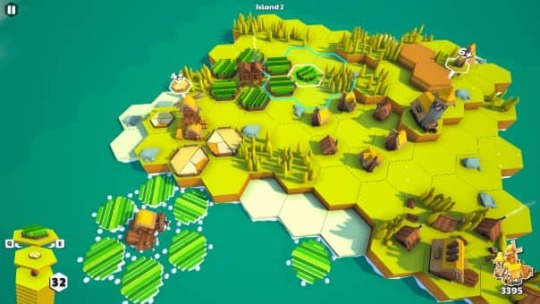
Match Village Review, is a minimalist puzzle and strategy experience about matching buildings to build villages on colorful islands. Match buildings to create your villages and cities on endless islands worldwide and enjoy the minimalistic and relaxing atmosphere, no resource management or armies, focus only on the building.
Match Village Review Pros:
- Nice graphics. - 232MB download size. - Puzzle gameplay. - Isometric view. - You can move the camera around and zoom in and out. - Win or lose the game will just roll into another map. - Each map is random. - Different biomes from forests to beaches and snow. - The gameplay is a case of putting 3 identical houses/amenities next to each other so they merge into a newly upgraded building. - When placing buildings etc you may get a positive or negative score number shown before placing. - Simple to learn. - A very good time waster and brain workout. - Touchscreen controls. - When a merge happens you get a few turns as a reward. - Game over is when you run out of turns or space, whatever comes first. - You can undo your last go. - Every piece has a radar to show if it hits/connects with other buildings etc. - As you score points you fill up an icon in the corner. - Photo mode. - Online leaderboards. - A lot of replay value. - Ambient soundtrack. - Every placable piece can be rotated. - Learning how everything works and goes together is great and a real draw if you are into that. Match Village Review Cons: - No tutorial. - Cannot rebind controls. - Takes a little while to get used to what the game wants of you. - The game doesn't mix it up a lot. - No help or guidance as to how the scoring and mechanics work. Related Posts: STAR WARS Battlefront Classic Collection Review (Steam) Match Village: Official website. Developer: Rising Moon Games Publisher: Qubyte Interactive Store Links - Nintendo Read the full article
1 note
·
View note